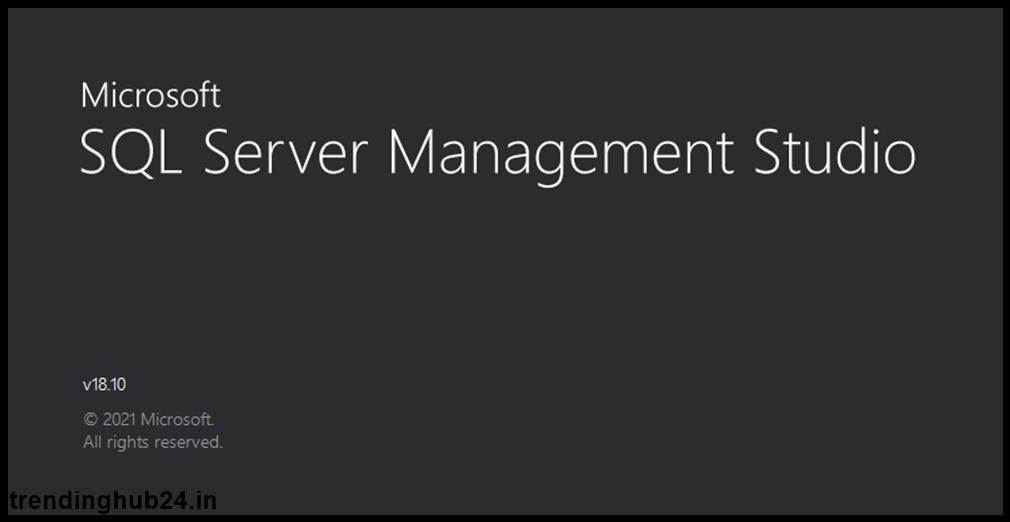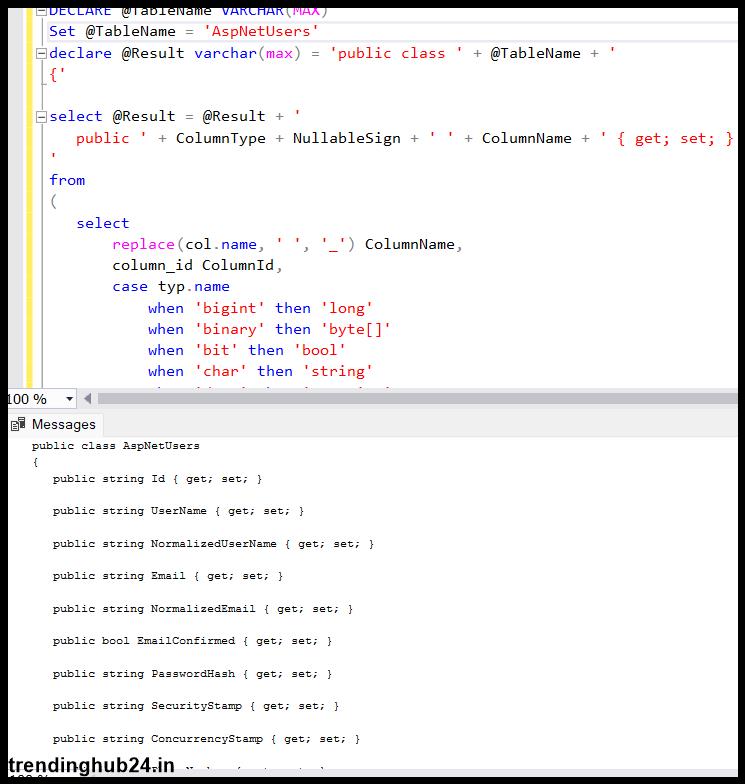🚀 Become a Verified Author on Trending Hub24
✍️ Author Account Available @ $60 / Month | +91 7355993756
Print get set properties for perticular table in Sql Server

simple steps for make Query for print get set properties for perticular table in Sql Server
Table of Contents
A property in C# is a member of the class that exposes the private fields of the class. Internally, C# properties are special methods called Accessors. A C# property has two connectors, a property getter or getter connector and a property setter connector. The Get connector returns a property value, and the Set connector sets a new value. The value keyword represents the value of the property.
Properties in C# and .NET have different access levels that are determined by the access modifier. Properties can be read-write properties, read-only properties, or write-only properties. The read-write property implements both access and group access. The write-only property implements a specified accessor, but it cannot be accessed. The read-only property implements the get extension, but there is no accessor defined.
Internally, in a C# class, properties are just a natural extension of data fields. Data encapsulation and hiding are fundamental properties of any object-oriented programming language. In C#, data encapsulation is possible through classes or structures. Using different access modifiers such as private, public, protected, and internal. it is possible to control the access of class members.
Normally, within a class, we declare a data field to be private and will provide a set of public SET and GET methods to access the data fields. This is a good programming practice as the data fields cannot be accessed directly outside the classroom. We have to use set/get methods to access data fields.
Properties can be private, public, protected, or internal. Additionally, properties can be any valid C# type. Note that the first part of the syntax looks very similar to the field declaration, and the second part consists of a get connector and a set connector.

DECLARE @TableName VARCHAR(MAX) Set @TableName = 'Your Table Name' declare @Result varchar(max) = 'public class ' + @TableName + ' {' select @Result = @Result + ' public ' + ColumnType + NullableSign + ' ' + ColumnName + ' { get; set; } ' from ( select replace(col.name, ' ', '_') ColumnName, column_id ColumnId, case typ.name when 'bigint' then 'long' when 'binary' then 'byte[]' when 'bit' then 'bool' when 'char' then 'string' when 'date' then 'DateTime' when 'datetime' then 'DateTime' when 'datetime2' then 'DateTime' when 'datetimeoffset' then 'DateTimeOffset' when 'decimal' then 'decimal' when 'float' then 'double' when 'image' then 'byte[]' when 'int' then 'int' when 'money' then 'decimal' when 'nchar' then 'string' when 'ntext' then 'string' when 'numeric' then 'decimal' when 'nvarchar' then 'string' when 'real' then 'float' when 'smalldatetime' then 'DateTime' when 'smallint' then 'short' when 'smallmoney' then 'decimal' when 'text' then 'string' when 'time' then 'TimeSpan' when 'timestamp' then 'long' when 'tinyint' then 'byte' when 'uniqueidentifier' then 'Guid' when 'varbinary' then 'byte[]' when 'varchar' then 'string' else 'UNKNOWN_' + typ.name end ColumnType, case when col.is_nullable = 1 and typ.name in ('bigint', 'bit', 'date', 'datetime', 'datetime2', 'datetimeoffset', 'decimal', 'float', 'int', 'money', 'numeric', 'real', 'smalldatetime', 'smallint', 'smallmoney', 'time', 'tinyint', 'uniqueidentifier') then '?' else '' end NullableSign from sys.columns col join sys.types typ on col.system_type_id = typ.system_type_id AND col.user_type_id = typ.user_type_id where object_id = object_id(@TableName) ) t order by ColumnId set @Result = @Result + ' }' print @Result
In general, you can assign a class model with the same name as table groups. Often, you check the structure of the table before creating the resources. But for now you need to pass the table name and class types.
After executing this program, run it using the SP parameters. The results will now be loaded as model categories.
SQL to c# class
I use SQL Server, open the database, and select.
Create a new query and clone the contents of the following script into it
Change the value of the @TableName variable to the name of the table from which you want to create a class
When you run the query, be sure to select the correct database, click Run, and get the representation of the C# class.
The output window displays a representation of the C# class.
Properties combine elements of all fields and paths. For a consumer of an item, the property looks like a field; Access to the property requires the same passwords. For a class user, the property is one or two blocks of code, representing a gate extension and/or an integrated extension. The Get accessor code block is executed when the property is read; When assigning a value to the property, the code block activates the set receiver. Non-contiguous properties are considered read-only. Assets without extensions are considered write-only. The property of both receivers is read-write. You can use the init accessor instead of the set accessor to make the property read-only.
Unlike Windows, attributes cannot be assigned as variables. Therefore, you cannot pass an attribute as a ref or an external parameter.
Attributes have several uses: They can validate data before allowing modification. You can also explicitly expose data from another source, such as a database. They can act when data changes, such as raising an event or changing the value of other fields.
In this example, "month" is defined as a property, so the configured extension can ensure that the value of "month" is set between 1 and 12. The "Month" attribute uses a special field to track the actual value. The physical structure of asset information is often referred to as an "asset pool". For real estate, private farms are often used as ancillary businesses. The field is marked as private to ensure that the property can only be changed upon call. For more information about restricting public and private access, see the section Access Modifiers.
Benefits of use
The human body poate cóci o cale The main reason is to return value to its proprietary value. Carrying out internal methods is similar, cu calcularea valorii unui activ for example and backaţi un wrapper privat de la import na facem acest lucrum, compilatorul va pune wrapper-ul în metode de apelare, deci nu estăriśi nizio modificati de a-l apela. You must use the computer carefully to gain additional time. For example, display the value of the private field _name:
The amount is fixed
Installation is a free return process. It uses useful parameters called values, which are types of properties. In the following example, the name of the group entry is added to the property:
